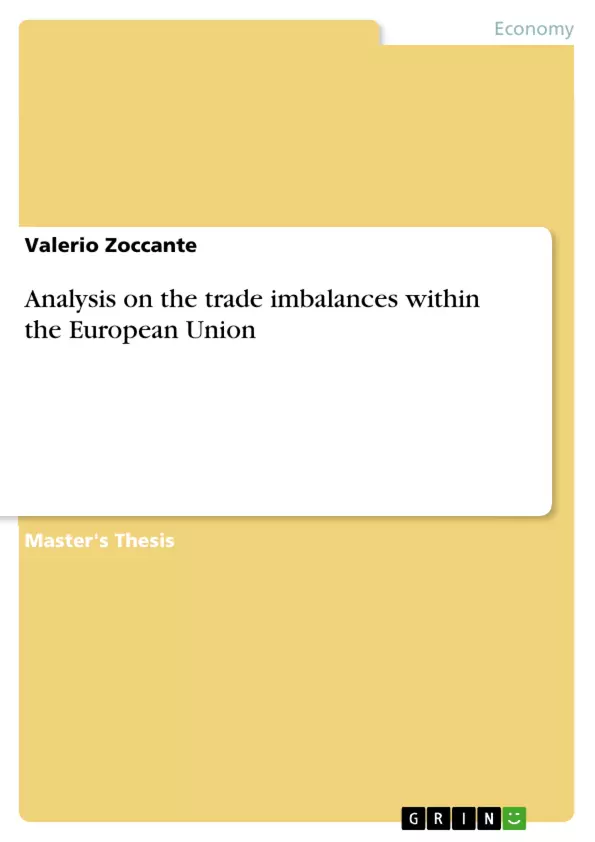The aim of this work is to assess the factors that have been affecting the imbalances of trade within countries of the European Union. The analysis takes into consideration the elements that could affect the balance of trade, thus saving or investment. The variables that are included in the panel data framework are related to productivity, inflation, consumption, wage level, capital movements, demography of the population, economic growth, public and private debt levels. A panel data, that leaves out countries from East Europe, is created, and takes values that go from 2002 to 2013.
The panel data shows that technology gaps and capital movements have been the main factors that affected the balance of trade of the peripheral countries. Peripheral countries did not invest enough in projects that could enhance the productivity, leading to a competitiveness loss that was not followed by a correction of the wage levels. Moreover, capital movements have been financing consumption surges in Greece and Portugal, whereas in Spain and Ireland those capitals have fueled credit booms and house bubbles. Therefore, those countries have been experiencing a worsening of their balance of trade, and investors have not been willed anymore to finance additional debt. Indeed, Members of the euroarea could not guarantee that the central bank could play the role of lender of last resort. Knowing that, in a currency union, the external position of a country represents its capacity of producing goods and services that could serve the debt in a troubled time, in the eyes of the investors the balances of trade of the peripheral eurozone countries became relevant during the European sovereign debt crisis.
In the European framework, in order to decrease the imbalances of trade within the Members, fiscal transfers to peripheral countries could be beneficial for decreasing the cost that peripheral countries need to undergo during the adjustment period, whereas reforms that aim to enhance productivity in the peripheral countries and increase the mobility and the flexibility of the product and labor markets could be highly helpful. The following work highlights all those elements in a empirical framework, relating, however, the results to the literature that has been developed around the European case and the optimum currency area.
Inhaltsverzeichnis (Table of Contents)
- Introduction...
- The balance of trade within the Members of the European Union......
- Problems with the management of the European Integration...
- Trade imbalances...
- Literature review.
- The financial markets integration and the intertemporal approach.………………….
- The competitiveness approach......
- Labor and product market flexibility..
- The empirical investigation.
- Assessing the main determinants..
- Data gathering..
- Results..
- Policy implications in the European framework..
- Interpretation of the results...
- The Maastricht treaty and the optimal currency area theory.
- The euroarea: ex-ante and ex-post considerations…..\li>
Zielsetzung und Themenschwerpunkte (Objectives and Key Themes)
This work aims to analyze the factors influencing trade imbalances among European Union countries. The analysis considers elements that could affect the trade balance, such as saving and investment. The study utilizes panel data from 2002 to 2013, excluding Eastern European countries, to investigate the impact of productivity, inflation, consumption, wage levels, capital movements, demographics, economic growth, and public and private debt levels on trade imbalances.
- Impact of productivity and capital movements on trade imbalances in peripheral countries.
- Role of capital movements in financing consumption surges and credit booms in Greece, Portugal, Spain, and Ireland.
- Importance of the balance of trade for investors during the European sovereign debt crisis.
- Need for coordinated economic policies in the euro area to minimize the costs of a currency union.
- Potential benefits of fiscal transfers and reforms to enhance productivity in peripheral countries.
Zusammenfassung der Kapitel (Chapter Summaries)
The first chapter provides an overview of the economic crisis and its impact on the European Union, highlighting the disparities between member states. Chapter 2 examines the balance of trade within the European Union, focusing on the challenges of managing European integration and trade imbalances. Chapter 3 delves into the literature review, exploring various perspectives on the integration of financial markets, competitiveness, and labor and product market flexibility. Chapter 4 presents the empirical investigation, assessing the main determinants of trade imbalances, data gathering methods, and results. Chapter 5 explores the policy implications for the European framework, interpreting the results, discussing the Maastricht treaty and the optimal currency area theory, and examining the euro area from ex-ante and ex-post perspectives.
Schlüsselwörter (Keywords)
The main keywords and focus topics of this work include trade imbalances, European Union, euro area, productivity, capital movements, competitiveness, labor market flexibility, economic growth, sovereign debt crisis, Maastricht treaty, optimal currency area, and fiscal transfers.
- Arbeit zitieren
- Valerio Zoccante (Autor:in), 2015, Analysis on the trade imbalances within the European Union, München, GRIN Verlag, https://www.grin.com/document/302136



